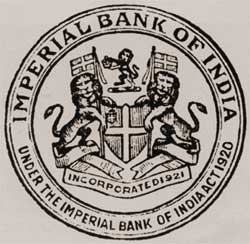This article includes a list of general references, but it lacks sufficient corresponding inline citations .(February 2019) |
 Emblem of the Imperial Bank of India | |
| Company type | Private (80%) |
|---|---|
| Industry | Banking, financial services |
| Predecessor |
|
| Founded | 27 January 1921 |
| Founder | John Maynard Keynes |
| Defunct | 1 July 1955 |
| Fate | Nationalization into State Bank of India in 1955 |
| Successor | |
| Headquarters | , |
Area served | British Raj |
The Imperial Bank of India (IBI) was one of the oldest and the largest commercial banks in India, and was subsequently renamed and nationalised as the State Bank of India in 1955. Initially, as per its royal charter, it acted as the central bank for India prior to the formation of the Reserve Bank of India (RBI) in 1935.